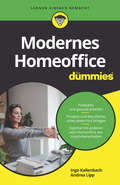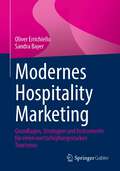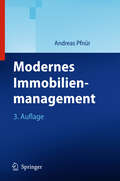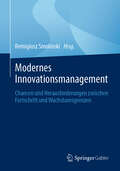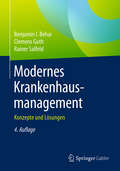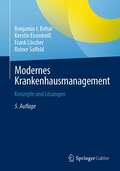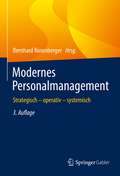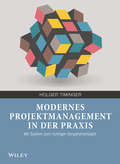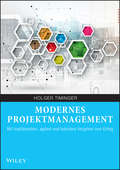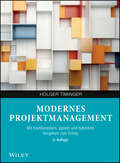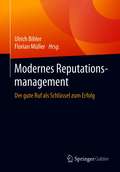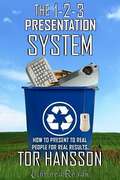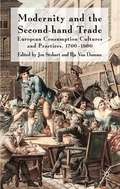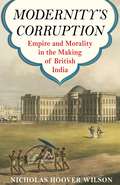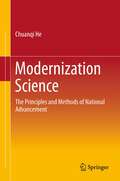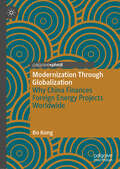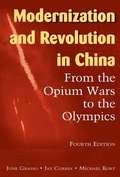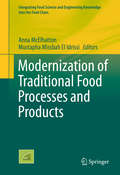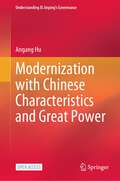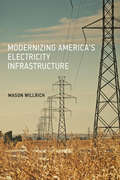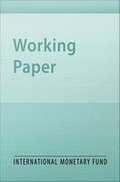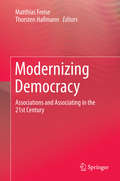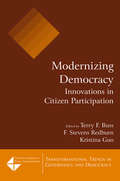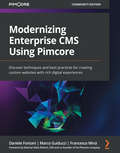- Table View
- List View
Modernes Homeoffice für Dummies (Für Dummies)
by Ingo Kallenbach Andrea LippHomeoffice ist für viele inzwischen Alltag geworden, Tendenz steigend. Vorbei die Zeiten, als Kollegen, die ab und zu von zu Hause arbeiteten, unter Verdacht standen, sich nur einen lauen Arbeitstag machen zu wollen. Trotzdem gibt es noch zahlreiche Fragen und Herausforderungen für viele Mitarbeiter, Führungskräfte, Unternehmen und Kunden: Wie ist Arbeit zu organisieren, wenn viele Mitarbeiter im Homeoffice sind, aber eben nicht alle? Wie bleiben wir in gutem Kontakt? Welche Arbeitsmittel und Schulungen werden benötigt? Und: Welche Chancen und Risiken verbergen sich in der Arbeitsform Homeoffice? Wie kann ich mein Büro zu Hause am besten einrichten und worauf muss ich dabei achten? Wie schaffe ich es, Berufliches und Privates im Homeoffice unter einen Hut zu bekommen? Wann ist Präsenz eben doch die bessere Wahl? Welche Haltung braucht es beim Einzelnen, in der Firma, bei der Führungskraft, damit "Homeoffice" gut gelingt? All diese Fragen und noch viele mehr beantwortet dieses Buch.
Modernes Hospitality Marketing: Grundlagen, Strategien und Instrumente für einen wertschöpfungsstarken Tourismus
by Oliver Errichiello Sandra BayerDieses Buch bietet einen fundierten Überblick über die aktuellen Herausforderungen im Tourismus und zeigt Lösungsansätze für ein wertschöpfendes Hospitality Marketing auf. Weltweite Krisen, Digitalisierung und Umweltbewusstsein haben das Reise- und Buchungsverhalten massiv verändert. Das Verlangen nach Urlaub ist zwar ungebrochen, doch der qualitative Anspruch an Hotels, Gastronomie und andere Dienstleister in den Destinationen steigt. Es gilt, die Erwartungen von Reisenden einfach, individuell, facettenreich sowie preislich adäquat und nachhaltig zu erfüllen.Die Autoren zeigen, wie diese komplexe Aufgabe vor dem Hintergrund hoher Fix- und Entwicklungskosten, kompetitiver Verdrängungsmärkte sowie verschärfter gesetzlicher Regulierungen gemeistert werden kann. Sie verknüpfen markensoziologische mit betriebswirtschaftlichen Erkenntnissen und Best Practice Insights, sodass Studierende und Praktiker gleichermaßen von der Lektüre des Buches profitieren.
Modernes IT-Management: Methodische Kombination von IT-Strategie und IT-Reifegradmodell
by Markus Mangiapane Roman P. BüchlerStrategie und Reifegradmodelle sind zeit- und ressourcenintensiv. Die Autoren legen einen Ansatz vor, der bekannte Modelle umsetzbar macht. Im Zentrum steht der IT-Leistungserbringer, der auf Basis der vier strategischen IT-Perspektiven Geschäftsprozessorientierung, Kundenorientierung, Operationelle Qualität und Zukunftsorientierung bewertet wird. Daraus wird die strategische IT-Ausrichtung abgeleitet.Um den konkreten Handlungsbedarf zu ermitteln, wird der IT-Leistungserbringer mit einem Reifegradmodell beurteilt und der neuen strategischen Ausrichtung gegenübergestellt. Das Vorgehen kombiniert bekannte Schritte zur nachhaltig organisierter Informatik mit hoher Verwertbarkeit in der Praxis.
Modernes Immobilienmanagement
by Andreas PfnürIn dem Buch wird erstmals die gesamte immobilienwirtschaftliche Wertschöpfungskette in einem geschlossenen Konzept behandelt - aus Sicht der Nutzer, Eigentümer und Betreiber von Gewerbeimmobilien. Der Autor zeigt, wie das Immobilieninvestmentmanagement, das Asset- und Property Management, das Corporate Real Estate Management sowie das Facility Management mithilfe betriebswirtschaftlicher Methoden optimiert werden kann. Die 3. Auflage wurde erheblich erweitert und berücksichtigt aktuellste Entwicklungen bei Immobilieninvestoren und -dienstleistern.
Modernes Innovationsmanagement: Chancen und Herausforderungen zwischen Fortschritt und Wachstumsgrenzen
by Remigiusz SmolinskiDieses Buch gibt Pionieren fortschrittswirksamer und gesellschaftsorientierter Innovationen aus Wirtschaft, Gesellschaft, Technik und Politik eine Plattform. Die Beitragsautoren wollen nicht nur über das aktuelle Innovationsparadigma und dessen Management in Unternehmen und Instituten diskutieren. Sie wollen auch anhand von Fallstudien und Best-Practice-Beispielen zeigen, was angesichts von Chancen und Herausforderungen sowie wirtschaftlichem und sozialem Fortschritt strukturell möglich und geboten ist. Unser Ziel ist es, mit dem Sammelband Anregungen zum Handeln zu vermitteln. Geplant ist daher, den Sammelband entlang relevanter anwendungsorientierter Bereiche der Innovations- und Fortschrittsforschung zu strukturieren: - Beschreibung eines neuen Innovationsparadigmas_Wie sieht das Wesen der Innovation, ihre Ursachen, ihre Werte und ihre Bedeutung im21. Jahrhundert aus? Wie können wir Kosten und Risiken bewältigen, gesellschaftlichen Fortschritt wie langfristiges wirtschaftliches Wachstum durch Innovation beschleunigen und gleichzeitig sicherstellen, dass Innovation für die Menschheit von Nutzen ist? - Förderung von Fortschritt und Wachstum_Wie können wir strukturell die Finanzierungs- und Anreizsysteme in Wissenschaft, Politik und Wirtschaft ändern, um mehr akademische sowie unternehmerische fortschrittswirkende Innovation zu fördern? - Etablierung einer neuen Innovationskultur_Wie können wir eine Innovationskultur etablieren, in der sich Menschen aktiv entschließen, sich mit den großen Herausforderungen des 21. Jahrhunderts zu befassen? Welche Paradigmen, Methoden und Strukturen helfen uns, das Wesen von Innovation auszurichten, sodass das Ergebnis einen Beitrag zu einer besseren und lebenswerteren Welt ermöglicht und nicht auf Gewinnmaximierung für Wenige optimiert? - Schaffung eines neuen Wirtschaftssystems_Wie lassen sich ökonomische Nachhaltigkeit, ökologische Nachhaltigkeit und soziale Nachhaltigkeit in neuen Geschäftsmodellen zusammenbringen? Wie können wir Unternehmen belohnen, die einen ökologischen und sozialen Mehrwert schaffen und z.B. klimaschädliches Verhalten bestrafen?
Modernes Krankenhausmanagement: Konzepte Und Lösungen
by Clemens Guth Benjamin I. Behar Rainer SalfeldDieses Buch zeigt Wege auf, wie jedes Krankenhaus die vermeintliche Quadratur des Kreises lösen kann: zum einen noch bessere medizinische und pflegerische Leistungen zu erbringen, zum andern nachhaltig die Gewinnschwelle zu erreichen. Auch wenn deutsche Krankenhäuser im internationalen Vergleich erstaunlich gut dastehen, so muss sich der gesamte Sektor weiterhin enormen Herausforderungen stellen: Rund die Hälfte der Häuser schreibt rote Zahlen, Wirtschaftlichkeit und finanzielle Basis werden von Jahr zu Jahr schwächer. Die Ideen, Konzepte und Vorschläge der Autoren, um diesen Entwicklungen gegenzusteuern, geben den neuesten Stand der nationalen und internationalen Reformdiskussion wieder. Zugrunde liegen eigene Erfahrungen in der Führung von Krankenhäusern, in Forschung und Lehre sowie in der Beratung von Krankenhäusern und Krankenhausgruppen im In- und Ausland. Für die vorliegende 4. Auflage wurden das Kapitel zu dem Leistungsgeschehen auf den Stationen komplett überarbeitet und ein Kapitel zur Wirtschaftlichkeit und dem Controlling des klinischen Betriebs ergänzt.
Modernes Krankenhausmanagement: Konzepte und Lösungen
by Benjamin I. Behar Rainer Salfeld Kerstin Eisenbeiß Frank LöscherDieses Buch zeigt Wege auf, wie jedes Krankenhaus die vermeintliche Quadratur des Kreises lösen kann: Zum einen noch bessere medizinische und pflegerische Leistungen zu erbringen und zum anderen nachhaltig die Gewinnschwelle zu erreichen. Dies in einem Umfeld, in dem die Bundesländer versuchen, sich zunehmend aus der Investitionsfinanzierung zurückzuziehen, während gleichzeitig die Krankenkassen und -versicherer wieder verstärkt auf Kostensenkungen im Krankenhausbetrieb drängen.Auch wenn sich deutsche Krankenhäuser im internationalen Vergleich erstaunlich gut behaupten, so stellt „Weitermachen wie bisher“ schon längst keine angemessene Antwort auf die vielfältigen Herausforderungen mehr dar. Wer im überaus anspruchsvollen gesundheitspolitischen Umfeld überleben will, muss vielmehr bereit sein, neue Initiativen zu entwickeln und mit dem nötigen langen Atem auch konsequent umzusetzen. Die hier vorgestellten Ideen, Konzepte und Vorschläge geben den neuesten Stand der nationalen und internationalen Reformdiskussion wieder. Zugrunde liegen eigene Erfahrungen der Autoren in der Führung von Krankenhäusern, in Forschung und Lehre sowie in der Beratung von Krankenhäusern und Krankenhausgruppen im In- und Ausland.Die 5. Auflage wurde um zwei neue Kapitel zu den Themen Bekämpfung künftiger Pandemiewellen und Digitalisierung im Gesundheitswesen ergänzt.
Modernes Personalmanagement: Strategisch – operativ – systemisch
by Bernhard RosenbergerDieses Buch beschreibt fundiert die fünf wesentlichen Handlungsfelder eines modernen Personalmanagements: Strategie, Organisation, Führung, Personalentwicklung, Personalsteuerung. Neu in der 3. Auflage sind unter anderem der Beitrag „Feedback – ein Muss für agiles Arbeiten“ und „Recruiting – Möglichkeiten und Chancen in Zeiten des Fachkräftemangels“.Personalmanagement ist eine der Kernfunktionen von Organisationen. Wie man die damit verbundenen Herausforderungen strategisch plant, systemisch betrachtet und im Zusammenspiel mit Führungskräften und Personalbereich operativ umsetzt, zeigen hier viele Experten mit langjähriger Erfahrung. Ein klar strukturiertes Praxishandbuch mit vielen Unternehmensbeispielen und Checklisten.
Modernes Projektmanagement in der Praxis: Mit System zum richtigen Vorgehensmodell
by Holger TimingerProjekte durchzuführen ist eine komplexe Angelegenheit. Das richtige Vorgehensmodell stellt dabei das Fundament für den späteren Projekterfolg dar, denn es führt die Projektbeteiligten strukturiert von der Idee bis zum gewünschten Ergebnis. Holger Timinger unterstützt Sie bei der Auswahl des zu Ihrem Projekt passenden Projektmanagementansatzes und der individuellen Anpassung der zugehörigen Methoden an die Erfordernisse Ihres Projekts. Dabei stellt er Ihnen gemäß einer modernen Betrachtungsweise Werkzeuge mit traditionellem, agilem oder hybridem Ansatz vor und beschreibt deren Stärken und Schwächen. Stets verständlich und mit vielen Beispielen ist dieses Buch Ihr Wegweiser zum richtigen Vorgehensmodell und damit zum Erfolg Ihrer Projekte.
Modernes Projektmanagement: Mit traditionellem, agilem und hybridem Vorgehen zum Erfolg
by Holger TimingerVon der digitalen und agilen Transformation versprechen sich Organisationen kürzere Innovationszyklen und effiziente Bearbeitung. Modernes, für die jeweilige Situation maßgeschneidertes Projektmanagement ist hierfür unerlsslich. Die vielen verschiedenen Ansätze, Standards und Normen können leicht verwirren. Holger Timinger erklärt in diesem Buch die traditionellen, agilen und hybriden Vorgehensweisen im Projektmanagement. Diese Vorgehensweisen werden klar voneinander unterscheidbar Situation für Situation dargestellt. Außerdem geht der Autor auf die Standards und Normen DIN 69901, ISO 21500, Individual Competence Baseline 4.0 der IPMA, PMI und PRINCE2 ein. So gibt Ihnen dieses Buch einen gut strukturierten Einblick in das moderne Projektmanagement.
Modernes Projektmanagement: Mit traditionellem, agilem und hybridem Vorgehen zum Erfolg
by Holger TimingerHolger Timinger erklärt in dieser aktualisierten und erweitertenNeuauflage die klassischen, agilen und hybriden Vorgehensweisen im Projektmanagement. Dieses Buch soll Sie in die Lage versetzen, passende Prozesse, Methoden, Werkzeuge und Rollen für die Bearbeitung einer individuellen Projektaufgabe einzusetzen, dabei geht er auch auf den strukturierenden Ordnungsrahmen HyProM ein. Sie werden erfahren, was traditionelles Projektmanagement auszeichnet und in welchen Situationen es Stärken und Schwächen hat. Daneben zeigt der Autor Ihnen, wann und wo man agiles Projektmanagement einsetzen soll. So kann man traditionelles und agiles Vorgehen kombinieren, wenn es sinnvoll ist. Das Buch greift dabei aktuelle Standards wie die Individual Competence Baseline (ICB) 4.0 der International Project Management Association (IPMA) und das PMBOK des Project Management Institutes (PMI) auf. Es ist eines der ersten Bücher, das hybrides Projektmanagement strukturiert und umfassend behandelt und dabei auf einen innovativen Ordnungsrahmen setzt. Der Ordnungsrahmen strukturiert Projektmanagementprozesse, Methoden und Werkzeuge sowie Rollen. Digitale Geschäftswelt, agile Transformation und Technologie- und Innovationsmanagement sind Schlagworte, die viele Unternehmen beschäftigen. Effizientes und effektives Projektmanagement kann hierzu einen wichtigen Beitrag leisten.
Modernes Reputationsmanagement: Der gute Ruf als Schlüssel zum Erfolg
by Ulrich Bihler Florian MüllerDieses Buch erklärt, wie modernes Reputationsmanagement von Unternehmen und Organisationen erfolgreich und nachhaltig gestaltet werden kann – insbesondere in volatilen Zeiten des digitalen und gesellschaftlichen Wandels. Emotionale Aspekte und vor allem die Frage, wofür ein Unternehmen steht und eintritt, spielen eine immer wichtigere Rolle – zum Beispiel bei der Kaufentscheidung des Kunden. Die Reputation eines Unternehmens als immaterieller Vermögenswert bestimmt damit maßgeblich den Erfolg und muss bei allen unternehmerischen Herausforderungen professionell, integriert und zielorientiert gemanagt werden. Die Beitragsautoren erläutern grundlegende Funktionsweisen von Unternehmensreputation sowie die Wirkmechanismen von Issues und Public Affairs Management für einen guten Ruf. Sie zeigen auf, wie beispielsweise Predictive Analytics, Purpose, Thought-Leadership-Strategien oder multisensuale Stakeholderkommunikation einen dringend notwendigen Perspektivwechsel herbeiführen und wie Interne Kommunikation sowie CEO-Kommunikation einen ganzheitlichen Reputationsansatz unterstützen können.Ein Buch voller überraschender Perspektiven, neuer Zusammenhänge, interessanter Insights und hilfreicher Praxistipps.
Modernist Impersonalities: How To Present To Real People For Real Results
by Tor HanssonThe bullet-point heavy PowerPoint presentation is an old standby. It's been used for so long that many industry experts feel it no longer does anything to increase information transfer, learning, or audienceengagement. As a matter of fact it appears to do the opposite. It is time to change how we communicate with our peers, our colleagues, our prospects, and our customers. A presentation is what the former Scandinavian Airlines CEO Jan Carlzon called a "moment of truth. " It is a critical opportunity to connect with key audiences. For the first time, real knowledge of how to connect with people, communicate clearly and engage an audience has been put into a consistent framework. THE 1-2-3 SYSTEM is based on sound communication principles, and on how people actually acquire and useinformation. It will help you vastly increase your effectiveness as a presenter. This is not another book full of vague suggestions and recycled truisms. It is a real system based on principles that can be learned and applied to any presentation. Switching from the old way of doing things to THE 1-2-3 SYSTEM, you will become more believable, more persuasive, and more effective.
Modernity and the Second-Hand Trade
by Jon Stobart Ilja Van DammeBringing together the latest research on the neglected area of second-hand exchange and consumption, this book offers fresh insights into the buying and selling of used goods in western-Europe during the eighteenth and nineteenth centuries, and seeks to re-examine and redefine the relationship between modernity and the second-hand trade.
Modernity's Corruption: Empire and Morality in the Making of British India
by Nicholas Hoover WilsonToday, “corruption” generally refers to pursuing personal interests at the expense of one’s responsibilities, the law, or the common good. It calls to mind some official violating their public duty for private gain, suggesting seamy bureaucracies taking payoffs, kickbacks, and bribes. Yet at other times, notions of corruption were rooted in a more expansive view of the causes of people’s behavior and the appropriate ways to regulate conduct. In this understanding, to be “corrupt” meant losing a delicate balance among competing appetites under specific circumstances and in the eyes of peers. Why did a narrower definition of corruption become dominant?Nicholas Hoover Wilson develops a new account of the changing category of corruption by examining the English East India Company and its transformation from a largely commercial enterprise to a militarized offshoot of British empire in the eighteenth and nineteenth centuries. He argues that the modern idea of corruption arose as an unintended consequence of conflicts among company officials and the changing audiences to which they justified themselves in Britain. This new understanding unified an imperial elite at risk of fragmenting into irreconcilable moral worlds and, in the process, helped redefine the boundaries of state, society, and economy. Modernity’s Corruption is at once a novel historical sociology of imperial administration and its contradictions, a fresh argument about the nature of corruption and its political and organizational effects, and a reinvigoration of classic arguments about the nature and consequences of global modernity.
Modernization Science: The Principles and Methods of National Advancement
by Chuanqi HeDepending on their national level of income, development and modernization, all countries in the world can be generally categorized as either advanced or developing. Studies on why advanced countries continue to develop, how they maintain their level of development, and how developing countries enter into the advanced club fall into the field of "modernization science," which is an emerging interdisciplinary science. This monograph, the first English book available on "modernization science," interprets its concepts, methodologies, general theories, first and second modernization, six level-specific, six field-specific and three sector-specific modernizations, modernization policy and evaluation, and the principles and methods of national development since the 18th century. It provides clear, systematic, up-to-date information on this new discipline with more than 173 figures and 265 tables, and covers 131 countries and 97% of the global population. A comprehensive outlook on world modernization is presented from a Chinese perspective.
Modernization Through Globalization: Why China Finances Foreign Energy Projects Worldwide
by Bo KongThis pivot considers how China deals with the globalization of its energy companies in the face of global efforts to combat climate change. It examines how China, following its emergence as the world’s largest energy consumer and its resultant growing dependence on foreign energy, engages the world on energy, and its implications for global governance of energy. It notably focuses on the policy impact of China’s global engagement for the accelerated “going out” strategy and the so-called “one belt one road” (OBOR) initiative, and profound climate implications for the rest of the world, contending that the type of energy services, technologies, and infrastructure China finances around the globe today will determine the global community’s carbon footprint in the foreseeable future.
Modernization and Revolution in China: From the Opium Wars to the Olympics
by June M Grasso Michael G. Kort Jay P CorrinExtensively revised and updated, this popular text conveys the drama of China's struggle to modernize against the backdrop of a proud and difficult history. Spanning the years from China's humiliating defeat in the Opium Wars to its triumphant hosting of the 2008 summer Olympics, the authors narrate the major developments of that journey: the breakdown of imperial China in the face of Japanese and Western encroachments; Sun-Yatsen and the founding of the Chinese republic; the early struggles between the ideologies and armies of Chiang Kai-shek and Mao Zedong; China's bitter and costly war with Japan; the final shootout that sent Chiang to Taiwan and Mao to Beijing; the turbulent first decades of the People's Republic; and the dramatic shift to a globalizing economic strategy. This edition features all new analysis of issues facing China's leaders today, including environmental challenges, rural economic developments, corruption, the current economic climate, China's relations with its neighbors and the United States, the latest Tibet crisis, and the reelection of Hu Jintao. The authors have also incorporated some of the latest scholarship on Chinese historical events, making this the best and most up-to-date brief text on modern China currently available.
Modernization of Traditional Food Processes and Products
by Anna Mcelhatton Mustapha Missbah El IdrissiThis volume of the Trilogy of Traditional Foods, part of the ISEKI Food Series, describes important aspects of the production of foods and beverages from all over the globe. The intention of this volume is to provide readers with an appreciation of how products were initially made, and which factors have shaped their development over time. Some modern products have remained local, while others are commodities that appear in peoples' cabinets all over the world. Modernization of Traditional Food Processes and Products is divided into two sections. The first section focuses on products originating in Europe, while the second section is a collection of products from the rest of the world. Each chapter describes the origin of a particular food or beverage and discusses the changes and the science that led to the modern products found on supermarket shelves. The international List of Contributors, which includes authors from China, Thailand, India, Argentina, New Zealand, and the United Kingdom, attests to the international collaboration for which the ISEKI Food Series is known. The volume is intended for both the practicing food professional and the interested reader.
Modernization with Chinese Characteristics and Great Power (Understanding Xi Jinping’s Governance)
by Angang HuThis open access book expounds in detail on the profound meaning and main characteristics of modernization with Chinese characteristics. This was done utilizing tools of historical investigation and fact-based research on the modernization of New China. The author provides a far-reaching outlook of the strategic goals and future trends of modernization with Chinese characteristics. In this book, the author answers the questions: What is modernization with Chinese characteristics? How did this modernization develop, and what are its main features? In what direction will it develop in the future? Why did China propose to basically realize the goal of socialist modernization by 2035? How can China achieve this ambitious goal on schedule? What major impact will this modernization have on China and the world? This book adheres to the concept of "knowledge for the people, knowledge for the country, and knowledge for mankind." It actively explores and summarizes the laws of modernization with Chinese characteristics and fully elucidates its characteristics. This book not only provides decision-makers with a basis for understanding national conditions and their national policy research, but also serves as an important reference for party members, cadres, and readers to understand the path of modernization with Chinese characteristics.
Modernizing America's Electricity Infrastructure (The\mit Press Ser.)
by Mason WillrichA comprehensive, coherent strategy for modernizing America's electricity infrastructure while ensuring affordable, reliable, secure, and environmentally sustainable electricity services.America's aging electricity infrastructure is deteriorating rapidly even as the need for highly reliable electric service—driven by the explosion of digital technology—continues to rise. Largely missing from national discussions, however, is a coherent, comprehensive national strategy for modernizing this critical infrastructure. Energy expert Mason Willrich presents just such a strategy in this book, connecting the dots across electric utilities, independent suppliers, government bureaucracies, political jurisdictions, and academic disciplines. He explains the need for a coherent approach, offers a framework for analyzing policy options, and proposes a step-by-step strategy for modernizing electrical infrastructure, end-to-end, in a way that ensures the delivery of affordable, reliable, secure, and environmentally sustainable electricity services.Willrich argues that an effective electrical infrastructure modernization strategy must incorporate flexibility, adaptability, and the capacity to coordinate policies at local, state, and federal levels. He reviews the history of America's electrification, from Edison's demonstration of the incandescent light bulb through the recent expansion of wind, solar, and energy efficiency as carbon-free energy resources. He describes the current ownership and operation of the electric industry and the complicated web of federal and state policies that govern it.
Modernizing Bank Regulation in Support of Financial Deepening: The Case of Uruguay
by Gustavo Adler Torsten Wezel Mario MansillaA report from the International Monetary Fund.
Modernizing Democracy
by Matthias Freise Thorsten HallmannModernizing Democracy brings together scholars focusing the role of associations and associating in contemporary societies. Organizations and associations have been identified as the "meso level of society" and as the "basic elements of democracy". They are important providers of welfare services and play an important role between the individual and political spheres. In recent years the environment of associations and associating has changed dramatically. Individualization, commercialization and globalization are challenging both democracy and the capability of associations to fulfill the functions attributed to them by social sciences. This change provides the central question of the volume: Is being part of an organization or association becoming an outdated model? And do associations still have the capacity of modernizing societies or are they just outdated remnants of post-democracy? The contributions to Modernizing Democracy will be organized into: Studying Association and Associating in the 21st Century, Associating in Times of Post-Democracy and Associations and the Challenge of Capitalist Development. The book will be attractive to third sector researchers as well as a broader academic community of political scientists, sociologists, economists, legal scientists and related disciplines.
Modernizing Democracy: Innovations in Citizen Participation (Transformational Trends In Governance And Democracy Ser.)
by Terry F. Buss F Stevens Redburn Kristina GuoHow do you put the "public" in public management? How can the traditional ethos of professionalism and technical expertise be reconciled with norms of representation and citizen participation at a time when technology is transforming communication between citizens and government - in some ways enhancing the exchange and in other ways complicating it? "Modernizing Democracy: Innovations in Citizen Participation" points the way. Written for public administration professionals, scholars, and students interested in citizen participation, it brings together new analyses of innovative practices, from hands-on community learning and focus groups to high-tech information systems and decision support technologies. The expert contributors illuminate the various roles that public administrators and leaders can play in fostering constructive, meaningful citizen involvement at all stages of the public policy process - from initiation and planning to feedback on public agency performance.
Modernizing Enterprise CMS Using Pimcore: Discover techniques and best practices for creating custom websites with rich digital experiences
by Daniele Fontani Marco Guiducci Francesco Mina Dietmar Dietz RietschA practical guide to developing, administering, and scaling content management solutions in your organization for supporting digital transformation using PimcoreKey FeaturesKick-start your CMS career by preparing for Pimcore developer certificationsCreate custom websites with a rich digital experience for your business users with the help of step-by-step examplesGet to grips with Pimcore's enterprise features for product management and data managementBook DescriptionUsed by over eighty thousand companies worldwide, Pimcore is the leading open source enterprise-level content management system (CMS) solution. It is an impressive alternative to conventional CMSes and is ideal for creating e-commerce and complex enterprise websites. This book helps developers working with standard CMSes such as WordPress and Drupal to use their knowledge of CMSes to learn Pimcore CMS in a practical way. You'll start by learning what Pimcore is and explore its various services such as PIM, MDM, and DAM. The book then shows you various techniques for developing custom websites in Pimcore based on the scale of your organization. You'll learn how to use Pimcore to improve the digital transformation of a company by implementing enterprise Pimcore features. As you advance, you'll discover Pimcore's capabilities and features that make it a faster and more secure alternative to traditional CMSes. As well as demonstrating practical use cases, Modernizing Enterprise CMS Using Pimcore can help you understand the benefits of using Pimcore as a CMS solution, sharing best practices and proven techniques for designing professional Pimcore sites. By the end of this book, you'll be a trained Pimcore developer, able to create complex websites, and be well-versed in Pimcore's enterprise features such as MDM, PIM, and DAM.What you will learnCreate, edit, and manage Pimcore documents for your web pagesManage web assets in Pimcore using the digital asset management (DAM) featureDiscover how to create layouts, templates, and custom widgets for your web pagesAdminister third-party add-ons for your Pimcore site using the admin UIDiscover practices to use Pimcore as a product information management (PIM) systemExplore Pimcore's master data management (MDM) for enterprise CMS developmentBuild reusable website components and save time using effective tips and tricksWho this book is forThis book is for web developers and CMS professionals looking for an alternative to WordPress and traditional CMS. Enterprise application developers looking for enterprise solutions for digital transformation will find this book useful. Beginner-level knowledge of PHP, HTML, and CSS is needed to understand the code examples used in the book.
